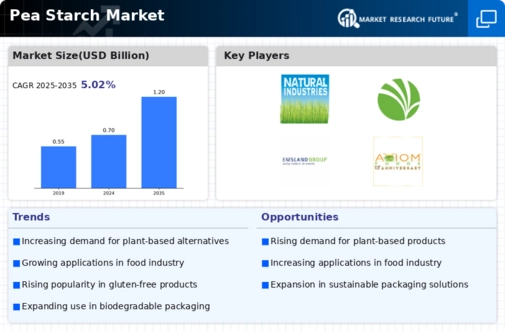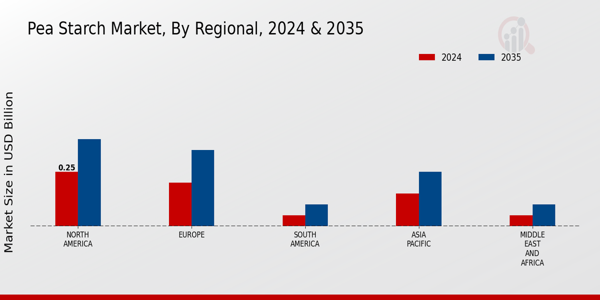-
FACTOR ANALYSIS
-
\r\n\r\n\r\nValue chain Analysis
-
\r\n\r\n\r\nPorter's
-
Five Forces Analysis
-
\r\n\r\n\r\nBargaining Power of Suppliers
-
\r\n\r\n\r\nBargaining
-
Power of Buyers
-
\r\n\r\n\r\nThreat of New Entrants
-
\r\n\r\n\r\nThreat
-
of Substitutes
-
\r\n\r\n\r\nIntensity of Rivalry
-
\r\n\r\n\r\n\r\n\r\nCOVID-19
-
Impact Analysis
-
\r\n\r\n\r\nMarket Impact Analysis
-
\r\n\r\n\r\nRegional
-
Impact
-
\r\n\r\n\r\nOpportunity and Threat Analysis
-
\r\n\r\n\r\n\r\n\r\n\r\n\r\n\r\n\r\nPea
-
Starch Market, BY Application (USD Billion)
-
\r\n\r\n\r\nFood
-
Beverages
-
\r\n\r\n\r\nAnimal Feed
-
\r\n\r\n\r\nPharmaceuticals
-
\r\n\r\n\r\nCosmetics
-
\r\n\r\n\r\nTextiles
-
\r\n\r\n\r\n\r\n\r\nPea
-
Starch Market, BY Type (USD Billion)
-
\r\n\r\n\r\nNative
-
Starch
-
\r\n\r\n\r\nModified Starch
-
\r\n\r\n\r\nPre-gelatinized
-
Starch
-
\r\n\r\n\r\n\r\n\r\nPea Starch Market, BY
-
Form (USD Billion)
-
\r\n\r\n\r\nPowder
-
\r\n\r\n\r\nGranules
-
\r\n\r\n\r\nLiquids
-
\r\n\r\n\r\n\r\n\r\nPea
-
Starch Market, BY End Use (USD Billion)
-
\r\n\r\n\r\nIndustrial
-
\r\n\r\n\r\nResidential
-
\r\n\r\n\r\n\r\n\r\nPea
-
Starch Market, BY Regional (USD Billion)
-
\r\n\r\n\r\nNorth
-
America
-
\r\n\r\n\r\nUS
-
\r\n\r\n\r\nCanada
-
\r\n\r\n\r\n\r\n\r\nEurope
-
\r\n\r\n\r\nGermany
-
\r\n\r\n\r\nUK
-
\r\n\r\n\r\nFrance
-
\r\n\r\n\r\nRussia
-
\r\n\r\n\r\nItaly
-
\r\n\r\n\r\nSpain
-
\r\n\r\n\r\nRest
-
of Europe
-
\r\n\r\n\r\n\r\n\r\nAPAC
-
\r\n\r\n\r\nChina
-
\r\n\r\n\r\nIndia
-
\r\n\r\n\r\nJapan
-
\r\n\r\n\r\nSouth
-
Korea
-
\r\n\r\n\r\nMalaysia
-
\r\n\r\n\r\nThailand
-
\r\n\r\n\r\nIndonesia
-
\r\n\r\n\r\nRest
-
of APAC
-
\r\n\r\n\r\n\r\n\r\nSouth America
-
\r\n\r\n\r\nBrazil
-
\r\n\r\n\r\nMexico
-
\r\n\r\n\r\nArgentina
-
\r\n\r\n\r\nRest
-
of South America
-
\r\n\r\n\r\n\r\n\r\nMEA
-
\r\n\r\n\r\nGCC
-
Countries
-
\r\n\r\n\r\nSouth Africa
-
\r\n\r\n\r\nRest
-
of MEA
-
\r\n\r\n\r\n\r\n\r\n\r\n\r\n\r\n\r\nCompetitive
-
Landscape
-
\r\n\r\n\r\nOverview
-
\r\n\r\n\r\nCompetitive
-
Analysis
-
\r\n\r\n\r\nMarket share Analysis
-
\r\n\r\n\r\nMajor
-
Growth Strategy in the Pea Starch Market
-
\r\n\r\n\r\nCompetitive
-
Benchmarking
-
\r\n\r\n\r\nLeading Players in Terms of Number of Developments
-
in the Pea Starch Market
-
\r\n\r\n\r\nKey developments and growth
-
strategies
-
\r\n\r\n\r\nNew Product Launch/Service Deployment
-
\r\n\r\n\r\nMerger
-
Acquisitions
-
\r\n\r\n\r\nJoint Ventures
-
\r\n\r\n\r\n\r\n\r\nMajor
-
Players Financial Matrix
-
\r\n\r\n\r\nSales and Operating Income
-
\r\n\r\n\r\nMajor
-
Players RD Expenditure. 2023
-
\r\n\r\n\r\n\r\n\r\n\r\n\r\nCompany
-
Profiles
-
\r\n\r\n\r\nAxiom Foods
-
\r\n\r\n\r\nFinancial
-
Overview
-
\r\n\r\n\r\nProducts Offered
-
\r\n\r\n\r\nKey
-
Developments
-
\r\n\r\n\r\nSWOT Analysis
-
\r\n\r\n\r\nKey
-
Strategies
-
\r\n\r\n\r\n\r\n\r\nAGT Food and Ingredients
-
\r\n\r\n\r\nFinancial
-
Overview
-
\r\n\r\n\r\nProducts Offered
-
\r\n\r\n\r\nKey
-
Developments
-
\r\n\r\n\r\nSWOT Analysis
-
\r\n\r\n\r\nKey
-
Strategies
-
\r\n\r\n\r\n\r\n\r\nNutriPea
-
\r\n\r\n\r\nFinancial
-
Overview
-
\r\n\r\n\r\nProducts Offered
-
\r\n\r\n\r\nKey
-
Developments
-
\r\n\r\n\r\nSWOT Analysis
-
\r\n\r\n\r\nKey
-
Strategies
-
\r\n\r\n\r\n\r\n\r\nPulses Canada
-
\r\n\r\n\r\nFinancial
-
Overview
-
\r\n\r\n\r\nProducts Offered
-
\r\n\r\n\r\nKey
-
Developments
-
\r\n\r\n\r\nSWOT Analysis
-
\r\n\r\n\r\nKey
-
Strategies
-
\r\n\r\n\r\n\r\n\r\nCargill
-
\r\n\r\n\r\nFinancial
-
Overview
-
\r\n\r\n\r\nProducts Offered
-
\r\n\r\n\r\nKey
-
Developments
-
\r\n\r\n\r\nSWOT Analysis
-
\r\n\r\n\r\nKey
-
Strategies
-
\r\n\r\n\r\n\r\n\r\nIngredion
-
\r\n\r\n\r\nFinancial
-
Overview
-
\r\n\r\n\r\nProducts Offered
-
\r\n\r\n\r\nKey
-
Developments
-
\r\n\r\n\r\nSWOT Analysis
-
\r\n\r\n\r\nKey
-
Strategies
-
\r\n\r\n\r\n\r\n\r\nPea Protein International
-
\r\n\r\n\r\nFinancial
-
Overview
-
\r\n\r\n\r\nProducts Offered
-
\r\n\r\n\r\nKey
-
Developments
-
\r\n\r\n\r\nSWOT Analysis
-
\r\n\r\n\r\nKey
-
Strategies
-
\r\n\r\n\r\n\r\n\r\nLegendary Foods
-
\r\n\r\n\r\nFinancial
-
Overview
-
\r\n\r\n\r\nProducts Offered
-
\r\n\r\n\r\nKey
-
Developments
-
\r\n\r\n\r\nSWOT Analysis
-
\r\n\r\n\r\nKey
-
Strategies
-
\r\n\r\n\r\n\r\n\r\nCosucra
-
\r\n\r\n\r\nFinancial
-
Overview
-
\r\n\r\n\r\nProducts Offered
-
\r\n\r\n\r\nKey
-
Developments
-
\r\n\r\n\r\nSWOT Analysis
-
\r\n\r\n\r\nKey
-
Strategies
-
\r\n\r\n\r\n\r\n\r\nEmsland Group
-
\r\n\r\n\r\nFinancial
-
Overview
-
\r\n\r\n\r\nProducts Offered
-
\r\n\r\n\r\nKey
-
Developments
-
\r\n\r\n\r\nSWOT Analysis
-
\r\n\r\n\r\nKey
-
Strategies
-
\r\n\r\n\r\n\r\n\r\nTate and Lyle
-
\r\n\r\n\r\nFinancial
-
Overview
-
\r\n\r\n\r\nProducts Offered
-
\r\n\r\n\r\nKey
-
Developments
-
\r\n\r\n\r\nSWOT Analysis
-
\r\n\r\n\r\nKey
-
Strategies
-
\r\n\r\n\r\n\r\n\r\nNatural Products Canada
-
\r\n\r\n\r\nFinancial
-
Overview
-
\r\n\r\n\r\nProducts Offered
-
\r\n\r\n\r\nKey
-
Developments
-
\r\n\r\n\r\nSWOT Analysis
-
\r\n\r\n\r\nKey
-
Strategies
-
\r\n\r\n\r\n\r\n\r\nGroupe Laiterie de SaintDenis
-
\r\n\r\n\r\nFinancial
-
Overview
-
\r\n\r\n\r\nProducts Offered
-
\r\n\r\n\r\nKey
-
Developments
-
\r\n\r\n\r\nSWOT Analysis
-
\r\n\r\n\r\nKey
-
Strategies
-
\r\n\r\n\r\n\r\n\r\n\r\n\r\nAppendix
-
\r\n\r\n\r\nReferences
-
\r\n\r\n\r\nRelated
-
Reports
-
\r\n\r\n\r\n\r\n\r\nLIST Of tables
-
\r\n\r\n\r\nLIST
-
OF ASSUMPTIONS
-
\r\n\r\n\r\nNorth America Pea Starch Market SIZE ESTIMATES
-
& FORECAST, BY APPLICATION, 2019-2035 (USD Billions)
-
\r\n\r\n\r\nNorth
-
America Pea Starch Market SIZE ESTIMATES & FORECAST, BY TYPE, 2019-2035 (USD
-
Billions)
-
\r\n\r\n\r\nNorth America Pea Starch Market SIZE ESTIMATES
-
& FORECAST, BY FORM, 2019-2035 (USD Billions)
-
\r\n\r\n\r\nNorth
-
America Pea Starch Market SIZE ESTIMATES & FORECAST, BY END USE, 2019-2035 (USD
-
Billions)
-
\r\n\r\n\r\nNorth America Pea Starch Market SIZE ESTIMATES
-
& FORECAST, BY REGIONAL, 2019-2035 (USD Billions)
-
\r\n\r\n\r\nUS
-
Pea Starch Market SIZE ESTIMATES & FORECAST, BY APPLICATION, 2019-2035 (USD
-
Billions)
-
\r\n\r\n\r\nUS Pea Starch Market SIZE ESTIMATES & FORECAST,
-
BY TYPE, 2019-2035 (USD Billions)
-
\r\n\r\n\r\nUS Pea Starch Market
-
SIZE ESTIMATES & FORECAST, BY FORM, 2019-2035 (USD Billions)
-
\r\n\r\n\r\nUS
-
Pea Starch Market SIZE ESTIMATES & FORECAST, BY END USE, 2019-2035 (USD Billions)
-
\r\n\r\n\r\nUS
-
Pea Starch Market SIZE ESTIMATES & FORECAST, BY REGIONAL, 2019-2035 (USD Billions)
-
\r\n\r\n\r\nCanada
-
Pea Starch Market SIZE ESTIMATES & FORECAST, BY APPLICATION, 2019-2035 (USD
-
Billions)
-
\r\n\r\n\r\nCanada Pea Starch Market SIZE ESTIMATES &
-
FORECAST, BY TYPE, 2019-2035 (USD Billions)
-
\r\n\r\n\r\nCanada Pea
-
Starch Market SIZE ESTIMATES & FORECAST, BY FORM, 2019-2035 (USD Billions)
-
\r\n\r\n\r\nCanada
-
Pea Starch Market SIZE ESTIMATES & FORECAST, BY END USE, 2019-2035 (USD Billions)
-
\r\n\r\n\r\nCanada
-
Pea Starch Market SIZE ESTIMATES & FORECAST, BY REGIONAL, 2019-2035 (USD Billions)
-
\r\n\r\n\r\nEurope
-
Pea Starch Market SIZE ESTIMATES & FORECAST, BY APPLICATION, 2019-2035 (USD
-
Billions)
-
\r\n\r\n\r\nEurope Pea Starch Market SIZE ESTIMATES &
-
FORECAST, BY TYPE, 2019-2035 (USD Billions)
-
\r\n\r\n\r\nEurope Pea
-
Starch Market SIZE ESTIMATES & FORECAST, BY FORM, 2019-2035 (USD Billions)
-
\r\n\r\n\r\nEurope
-
Pea Starch Market SIZE ESTIMATES & FORECAST, BY END USE, 2019-2035 (USD Billions)
-
\r\n\r\n\r\nEurope
-
Pea Starch Market SIZE ESTIMATES & FORECAST, BY REGIONAL, 2019-2035 (USD Billions)
-
\r\n\r\n\r\nGermany
-
Pea Starch Market SIZE ESTIMATES & FORECAST, BY APPLICATION, 2019-2035 (USD
-
Billions)
-
\r\n\r\n\r\nGermany Pea Starch Market SIZE ESTIMATES &
-
FORECAST, BY TYPE, 2019-2035 (USD Billions)
-
\r\n\r\n\r\nGermany Pea
-
Starch Market SIZE ESTIMATES & FORECAST, BY FORM, 2019-2035 (USD Billions)
-
\r\n\r\n\r\nGermany
-
Pea Starch Market SIZE ESTIMATES & FORECAST, BY END USE, 2019-2035 (USD Billions)
-
\r\n\r\n\r\nGermany
-
Pea Starch Market SIZE ESTIMATES & FORECAST, BY REGIONAL, 2019-2035 (USD Billions)
-
\r\n\r\n\r\nUK
-
Pea Starch Market SIZE ESTIMATES & FORECAST, BY APPLICATION, 2019-2035 (USD
-
Billions)
-
\r\n\r\n\r\nUK Pea Starch Market SIZE ESTIMATES & FORECAST,
-
BY TYPE, 2019-2035 (USD Billions)
-
\r\n\r\n\r\nUK Pea Starch Market
-
SIZE ESTIMATES & FORECAST, BY FORM, 2019-2035 (USD Billions)
-
\r\n\r\n\r\nUK
-
Pea Starch Market SIZE ESTIMATES & FORECAST, BY END USE, 2019-2035 (USD Billions)
-
\r\n\r\n\r\nUK
-
Pea Starch Market SIZE ESTIMATES & FORECAST, BY REGIONAL, 2019-2035 (USD Billions)
-
\r\n\r\n\r\nFrance
-
Pea Starch Market SIZE ESTIMATES & FORECAST, BY APPLICATION, 2019-2035 (USD
-
Billions)
-
\r\n\r\n\r\nFrance Pea Starch Market SIZE ESTIMATES &
-
FORECAST, BY TYPE, 2019-2035 (USD Billions)
-
\r\n\r\n\r\nFrance Pea
-
Starch Market SIZE ESTIMATES & FORECAST, BY FORM, 2019-2035 (USD Billions)
-
\r\n\r\n\r\nFrance
-
Pea Starch Market SIZE ESTIMATES & FORECAST, BY END USE, 2019-2035 (USD Billions)
-
\r\n\r\n\r\nFrance
-
Pea Starch Market SIZE ESTIMATES & FORECAST, BY REGIONAL, 2019-2035 (USD Billions)
-
\r\n\r\n\r\nRussia
-
Pea Starch Market SIZE ESTIMATES & FORECAST, BY APPLICATION, 2019-2035 (USD
-
Billions)
-
\r\n\r\n\r\nRussia Pea Starch Market SIZE ESTIMATES &
-
FORECAST, BY TYPE, 2019-2035 (USD Billions)
-
\r\n\r\n\r\nRussia Pea
-
Starch Market SIZE ESTIMATES & FORECAST, BY FORM, 2019-2035 (USD Billions)
-
\r\n\r\n\r\nRussia
-
Pea Starch Market SIZE ESTIMATES & FORECAST, BY END USE, 2019-2035 (USD Billions)
-
\r\n\r\n\r\nRussia
-
Pea Starch Market SIZE ESTIMATES & FORECAST, BY REGIONAL, 2019-2035 (USD Billions)
-
\r\n\r\n\r\nItaly
-
Pea Starch Market SIZE ESTIMATES & FORECAST, BY APPLICATION, 2019-2035 (USD
-
Billions)
-
\r\n\r\n\r\nItaly Pea Starch Market SIZE ESTIMATES &
-
FORECAST, BY TYPE, 2019-2035 (USD Billions)
-
\r\n\r\n\r\nItaly Pea
-
Starch Market SIZE ESTIMATES & FORECAST, BY FORM, 2019-2035 (USD Billions)
-
\r\n\r\n\r\nItaly
-
Pea Starch Market SIZE ESTIMATES & FORECAST, BY END USE, 2019-2035 (USD Billions)
-
\r\n\r\n\r\nItaly
-
Pea Starch Market SIZE ESTIMATES & FORECAST, BY REGIONAL, 2019-2035 (USD Billions)
-
\r\n\r\n\r\nSpain
-
Pea Starch Market SIZE ESTIMATES & FORECAST, BY APPLICATION, 2019-2035 (USD
-
Billions)
-
\r\n\r\n\r\nSpain Pea Starch Market SIZE ESTIMATES &
-
FORECAST, BY TYPE, 2019-2035 (USD Billions)
-
\r\n\r\n\r\nSpain Pea
-
Starch Market SIZE ESTIMATES & FORECAST, BY FORM, 2019-2035 (USD Billions)
-
\r\n\r\n\r\nSpain
-
Pea Starch Market SIZE ESTIMATES & FORECAST, BY END USE, 2019-2035 (USD Billions)
-
\r\n\r\n\r\nSpain
-
Pea Starch Market SIZE ESTIMATES & FORECAST, BY REGIONAL, 2019-2035 (USD Billions)
-
\r\n\r\n\r\nRest
-
of Europe Pea Starch Market SIZE ESTIMATES & FORECAST, BY APPLICATION, 2019-2035
-
(USD Billions)
-
\r\n\r\n\r\nRest of Europe Pea Starch Market SIZE
-
ESTIMATES & FORECAST, BY TYPE, 2019-2035 (USD Billions)
-
\r\n\r\n\r\nRest
-
of Europe Pea Starch Market SIZE ESTIMATES & FORECAST, BY FORM, 2019-2035 (USD
-
Billions)
-
\r\n\r\n\r\nRest of Europe Pea Starch Market SIZE ESTIMATES
-
& FORECAST, BY END USE, 2019-2035 (USD Billions)
-
\r\n\r\n\r\nRest
-
of Europe Pea Starch Market SIZE ESTIMATES & FORECAST, BY REGIONAL, 2019-2035
-
(USD Billions)
-
\r\n\r\n\r\nAPAC Pea Starch Market SIZE ESTIMATES
-
& FORECAST, BY APPLICATION, 2019-2035 (USD Billions)
-
\r\n\r\n\r\nAPAC
-
Pea Starch Market SIZE ESTIMATES & FORECAST, BY TYPE, 2019-2035 (USD Billions)
-
\r\n\r\n\r\nAPAC
-
Pea Starch Market SIZE ESTIMATES & FORECAST, BY FORM, 2019-2035 (USD Billions)
-
\r\n\r\n\r\nAPAC
-
Pea Starch Market SIZE ESTIMATES & FORECAST, BY END USE, 2019-2035 (USD Billions)
-
\r\n\r\n\r\nAPAC
-
Pea Starch Market SIZE ESTIMATES & FORECAST, BY REGIONAL, 2019-2035 (USD Billions)
-
\r\n\r\n\r\nChina
-
Pea Starch Market SIZE ESTIMATES & FORECAST, BY APPLICATION, 2019-2035 (USD
-
Billions)
-
\r\n\r\n\r\nChina Pea Starch Market SIZE ESTIMATES &
-
FORECAST, BY TYPE, 2019-2035 (USD Billions)
-
\r\n\r\n\r\nChina Pea
-
Starch Market SIZE ESTIMATES & FORECAST, BY FORM, 2019-2035 (USD Billions)
-
\r\n\r\n\r\nChina
-
Pea Starch Market SIZE ESTIMATES & FORECAST, BY END USE, 2019-2035 (USD Billions)
-
\r\n\r\n\r\nChina
-
Pea Starch Market SIZE ESTIMATES & FORECAST, BY REGIONAL, 2019-2035 (USD Billions)
-
\r\n\r\n\r\nIndia
-
Pea Starch Market SIZE ESTIMATES & FORECAST, BY APPLICATION, 2019-2035 (USD
-
Billions)
-
\r\n\r\n\r\nIndia Pea Starch Market SIZE ESTIMATES &
-
FORECAST, BY TYPE, 2019-2035 (USD Billions)
-
\r\n\r\n\r\nIndia Pea
-
Starch Market SIZE ESTIMATES & FORECAST, BY FORM, 2019-2035 (USD Billions)
-
\r\n\r\n\r\nIndia
-
Pea Starch Market SIZE ESTIMATES & FORECAST, BY END USE, 2019-2035 (USD Billions)
-
\r\n\r\n\r\nIndia
-
Pea Starch Market SIZE ESTIMATES & FORECAST, BY REGIONAL, 2019-2035 (USD Billions)
-
\r\n\r\n\r\nJapan
-
Pea Starch Market SIZE ESTIMATES & FORECAST, BY APPLICATION, 2019-2035 (USD
-
Billions)
-
\r\n\r\n\r\nJapan Pea Starch Market SIZE ESTIMATES &
-
FORECAST, BY TYPE, 2019-2035 (USD Billions)
-
\r\n\r\n\r\nJapan Pea
-
Starch Market SIZE ESTIMATES & FORECAST, BY FORM, 2019-2035 (USD Billions)
-
\r\n\r\n\r\nJapan
-
Pea Starch Market SIZE ESTIMATES & FORECAST, BY END USE, 2019-2035 (USD Billions)
-
\r\n\r\n\r\nJapan
-
Pea Starch Market SIZE ESTIMATES & FORECAST, BY REGIONAL, 2019-2035 (USD Billions)
-
\r\n\r\n\r\nSouth
-
Korea Pea Starch Market SIZE ESTIMATES & FORECAST, BY APPLICATION, 2019-2035
-
(USD Billions)
-
\r\n\r\n\r\nSouth Korea Pea Starch Market SIZE ESTIMATES
-
& FORECAST, BY TYPE, 2019-2035 (USD Billions)
-
\r\n\r\n\r\nSouth
-
Korea Pea Starch Market SIZE ESTIMATES & FORECAST, BY FORM, 2019-2035 (USD Billions)
-
\r\n\r\n\r\nSouth
-
Korea Pea Starch Market SIZE ESTIMATES & FORECAST, BY END USE, 2019-2035 (USD
-
Billions)
-
\r\n\r\n\r\nSouth Korea Pea Starch Market SIZE ESTIMATES
-
& FORECAST, BY REGIONAL, 2019-2035 (USD Billions)
-
\r\n\r\n\r\nMalaysia
-
Pea Starch Market SIZE ESTIMATES & FORECAST, BY APPLICATION, 2019-2035 (USD
-
Billions)
-
\r\n\r\n\r\nMalaysia Pea Starch Market SIZE ESTIMATES &
-
FORECAST, BY TYPE, 2019-2035 (USD Billions)
-
\r\n\r\n\r\nMalaysia
-
Pea Starch Market SIZE ESTIMATES & FORECAST, BY FORM, 2019-2035 (USD Billions)
-
\r\n\r\n\r\nMalaysia
-
Pea Starch Market SIZE ESTIMATES & FORECAST, BY END USE, 2019-2035 (USD Billions)
-
\r\n\r\n\r\nMalaysia
-
Pea Starch Market SIZE ESTIMATES & FORECAST, BY REGIONAL, 2019-2035 (USD Billions)
-
\r\n\r\n\r\nThailand
-
Pea Starch Market SIZE ESTIMATES & FORECAST, BY APPLICATION, 2019-2035 (USD
-
Billions)
-
\r\n\r\n\r\nThailand Pea Starch Market SIZE ESTIMATES &
-
FORECAST, BY TYPE, 2019-2035 (USD Billions)
-
\r\n\r\n\r\nThailand
-
Pea Starch Market SIZE ESTIMATES & FORECAST, BY FORM, 2019-2035 (USD Billions)
-
\r\n\r\n\r\nThailand
-
Pea Starch Market SIZE ESTIMATES & FORECAST, BY END USE, 2019-2035 (USD Billions)
-
\r\n\r\n\r\nThailand
-
Pea Starch Market SIZE ESTIMATES & FORECAST, BY REGIONAL, 2019-2035 (USD Billions)
-
\r\n\r\n\r\nIndonesia
-
Pea Starch Market SIZE ESTIMATES & FORECAST, BY APPLICATION, 2019-2035 (USD
-
Billions)
-
\r\n\r\n\r\nIndonesia Pea Starch Market SIZE ESTIMATES
-
& FORECAST, BY TYPE, 2019-2035 (USD Billions)
-
\r\n\r\n\r\nIndonesia
-
Pea Starch Market SIZE ESTIMATES & FORECAST, BY FORM, 2019-2035 (USD Billions)
-
\r\n\r\n\r\nIndonesia
-
Pea Starch Market SIZE ESTIMATES & FORECAST, BY END USE, 2019-2035 (USD Billions)
-
\r\n\r\n\r\nIndonesia
-
Pea Starch Market SIZE ESTIMATES & FORECAST, BY REGIONAL, 2019-2035 (USD Billions)
-
\r\n\r\n\r\nRest
-
of APAC Pea Starch Market SIZE ESTIMATES & FORECAST, BY APPLICATION, 2019-2035
-
(USD Billions)
-
\r\n\r\n\r\nRest of APAC Pea Starch Market SIZE ESTIMATES
-
& FORECAST, BY TYPE, 2019-2035 (USD Billions)
-
\r\n\r\n\r\nRest
-
of APAC Pea Starch Market SIZE ESTIMATES & FORECAST, BY FORM, 2019-2035 (USD
-
Billions)
-
\r\n\r\n\r\nRest of APAC Pea Starch Market SIZE ESTIMATES
-
& FORECAST, BY END USE, 2019-2035 (USD Billions)
-
\r\n\r\n\r\nRest
-
of APAC Pea Starch Market SIZE ESTIMATES & FORECAST, BY REGIONAL, 2019-2035
-
(USD Billions)
-
\r\n\r\n\r\nSouth America Pea Starch Market SIZE ESTIMATES
-
& FORECAST, BY APPLICATION, 2019-2035 (USD Billions)
-
\r\n\r\n\r\nSouth
-
America Pea Starch Market SIZE ESTIMATES & FORECAST, BY TYPE, 2019-2035 (USD
-
Billions)
-
\r\n\r\n\r\nSouth America Pea Starch Market SIZE ESTIMATES
-
& FORECAST, BY FORM, 2019-2035 (USD Billions)
-
\r\n\r\n\r\nSouth
-
America Pea Starch Market SIZE ESTIMATES & FORECAST, BY END USE, 2019-2035 (USD
-
Billions)
-
\r\n\r\n\r\nSouth America Pea Starch Market SIZE ESTIMATES
-
& FORECAST, BY REGIONAL, 2019-2035 (USD Billions)
-
\r\n\r\n\r\nBrazil
-
Pea Starch Market SIZE ESTIMATES & FORECAST, BY APPLICATION, 2019-2035 (USD
-
Billions)
-
\r\n\r\n\r\nBrazil Pea Starch Market SIZE ESTIMATES &
-
FORECAST, BY TYPE, 2019-2035 (USD Billions)
-
\r\n\r\n\r\nBrazil Pea
-
Starch Market SIZE ESTIMATES & FORECAST, BY FORM, 2019-2035 (USD Billions)
-
\r\n\r\n\r\nBrazil
-
Pea Starch Market SIZE ESTIMATES & FORECAST, BY END USE, 2019-2035 (USD Billions)
-
\r\n\r\n\r\nBrazil
-
Pea Starch Market SIZE ESTIMATES & FORECAST, BY REGIONAL, 2019-2035 (USD Billions)
-
\r\n\r\n\r\nMexico
-
Pea Starch Market SIZE ESTIMATES & FORECAST, BY APPLICATION, 2019-2035 (USD
-
Billions)
-
\r\n\r\n\r\nMexico Pea Starch Market SIZE ESTIMATES &
-
FORECAST, BY TYPE, 2019-2035 (USD Billions)
-
\r\n\r\n\r\nMexico Pea
-
Starch Market SIZE ESTIMATES & FORECAST, BY FORM, 2019-2035 (USD Billions)
-
\r\n\r\n\r\nMexico
-
Pea Starch Market SIZE ESTIMATES & FORECAST, BY END USE, 2019-2035 (USD Billions)
-
\r\n\r\n\r\nMexico
-
Pea Starch Market SIZE ESTIMATES & FORECAST, BY REGIONAL, 2019-2035 (USD Billions)
-
\r\n\r\n\r\nArgentina
-
Pea Starch Market SIZE ESTIMATES & FORECAST, BY APPLICATION, 2019-2035 (USD
-
Billions)
-
\r\n\r\n\r\nArgentina Pea Starch Market SIZE ESTIMATES
-
& FORECAST, BY TYPE, 2019-2035 (USD Billions)
-
\r\n\r\n\r\nArgentina
-
Pea Starch Market SIZE ESTIMATES & FORECAST, BY FORM, 2019-2035 (USD Billions)
-
\r\n\r\n\r\nArgentina
-
Pea Starch Market SIZE ESTIMATES & FORECAST, BY END USE, 2019-2035 (USD Billions)
-
\r\n\r\n\r\nArgentina
-
Pea Starch Market SIZE ESTIMATES & FORECAST, BY REGIONAL, 2019-2035 (USD Billions)
-
\r\n\r\n\r\nRest
-
of South America Pea Starch Market SIZE ESTIMATES & FORECAST, BY APPLICATION,
-
\r\n\r\n\r\nRest of South America Pea Starch
-
Market SIZE ESTIMATES & FORECAST, BY TYPE, 2019-2035 (USD Billions)
-
\r\n\r\n\r\nRest
-
of South America Pea Starch Market SIZE ESTIMATES & FORECAST, BY FORM, 2019-2035
-
(USD Billions)
-
\r\n\r\n\r\nRest of South America Pea Starch Market
-
SIZE ESTIMATES & FORECAST, BY END USE, 2019-2035 (USD Billions)
-
\r\n\r\n\r\nRest
-
of South America Pea Starch Market SIZE ESTIMATES & FORECAST, BY REGIONAL, 2019-2035
-
(USD Billions)
-
\r\n\r\n\r\nMEA Pea Starch Market SIZE ESTIMATES &
-
FORECAST, BY APPLICATION, 2019-2035 (USD Billions)
-
\r\n\r\n\r\nMEA
-
Pea Starch Market SIZE ESTIMATES & FORECAST, BY TYPE, 2019-2035 (USD Billions)
-
\r\n\r\n\r\nMEA
-
Pea Starch Market SIZE ESTIMATES & FORECAST, BY FORM, 2019-2035 (USD Billions)
-
\r\n\r\n\r\nMEA
-
Pea Starch Market SIZE ESTIMATES & FORECAST, BY END USE, 2019-2035 (USD Billions)
-
\r\n\r\n\r\nMEA
-
Pea Starch Market SIZE ESTIMATES & FORECAST, BY REGIONAL, 2019-2035 (USD Billions)
-
\r\n\r\n\r\nGCC
-
Countries Pea Starch Market SIZE ESTIMATES & FORECAST, BY APPLICATION, 2019-2035
-
(USD Billions)
-
\r\n\r\n\r\nGCC Countries Pea Starch Market SIZE ESTIMATES
-
& FORECAST, BY TYPE, 2019-2035 (USD Billions)
-
\r\n\r\n\r\nGCC
-
Countries Pea Starch Market SIZE ESTIMATES & FORECAST, BY FORM, 2019-2035 (USD
-
Billions)
-
\r\n\r\n\r\nGCC Countries Pea Starch Market SIZE ESTIMATES
-
& FORECAST, BY END USE, 2019-2035 (USD Billions)
-
\r\n\r\n\r\nGCC
-
Countries Pea Starch Market SIZE ESTIMATES & FORECAST, BY REGIONAL, 2019-2035
-
(USD Billions)
-
\r\n\r\n\r\nSouth Africa Pea Starch Market SIZE ESTIMATES
-
& FORECAST, BY APPLICATION, 2019-2035 (USD Billions)
-
\r\n\r\n\r\nSouth
-
Africa Pea Starch Market SIZE ESTIMATES & FORECAST, BY TYPE, 2019-2035 (USD
-
Billions)
-
\r\n\r\n\r\nSouth Africa Pea Starch Market SIZE ESTIMATES
-
& FORECAST, BY FORM, 2019-2035 (USD Billions)
-
\r\n\r\n\r\nSouth
-
Africa Pea Starch Market SIZE ESTIMATES & FORECAST, BY END USE, 2019-2035 (USD
-
Billions)
-
\r\n\r\n\r\nSouth Africa Pea Starch Market SIZE ESTIMATES
-
& FORECAST, BY REGIONAL, 2019-2035 (USD Billions)
-
\r\n\r\n\r\nRest
-
of MEA Pea Starch Market SIZE ESTIMATES & FORECAST, BY APPLICATION, 2019-2035
-
(USD Billions)
-
\r\n\r\n\r\nRest of MEA Pea Starch Market SIZE ESTIMATES
-
& FORECAST, BY TYPE, 2019-2035 (USD Billions)
-
\r\n\r\n\r\nRest
-
of MEA Pea Starch Market SIZE ESTIMATES & FORECAST, BY FORM, 2019-2035 (USD
-
Billions)
-
\r\n\r\n\r\nRest of MEA Pea Starch Market SIZE ESTIMATES
-
& FORECAST, BY END USE, 2019-2035 (USD Billions)
-
\r\n\r\n\r\nRest
-
of MEA Pea Starch Market SIZE ESTIMATES & FORECAST, BY REGIONAL, 2019-2035 (USD
-
Billions)
-
\r\n\r\n\r\nPRODUCT LAUNCH/PRODUCT DEVELOPMENT/APPROVAL
-
\r\n\r\n\r\nACQUISITION/PARTNERSHIP
-
\r\n\r\n\r\n
-
\r\n
-
\r\n
-
\r\n
-
\r\n
-
\r\n
-
\r\n
-
\r\n
-
\r\n
-
\r\n
-
\r\n
-
\r\n
-
\r\n
-
\r\n
-
\r\n
-
\r\n
-
\r\n
-
\r\n
-
\r\n
-
\r\n
-
\r\n
-
\r\n
-
\r\n
-
\r\n
-
\r\n
-
\r\n
-
\r\n
-
\r\n
-
\r\n
-
\r\nLIST
-
Of figures
-
\r\n
-
\r\n\r\n\r\nMARKET SYNOPSIS
-
\r\n\r\n\r\nNORTH
-
AMERICA PEA STARCH MARKET ANALYSIS
-
\r\n\r\n\r\nUS PEA STARCH MARKET
-
ANALYSIS BY APPLICATION
-
\r\n\r\n\r\nUS PEA STARCH MARKET ANALYSIS
-
BY TYPE
-
\r\n\r\n\r\nUS PEA STARCH MARKET ANALYSIS BY FORM
-
\r\n\r\n\r\nUS
-
PEA STARCH MARKET ANALYSIS BY END USE
-
\r\n\r\n\r\nUS PEA STARCH MARKET
-
ANALYSIS BY REGIONAL
-
\r\n\r\n\r\nCANADA PEA STARCH MARKET ANALYSIS
-
BY APPLICATION
-
\r\n\r\n\r\nCANADA PEA STARCH MARKET ANALYSIS BY TYPE
-
\r\n\r\n\r\nCANADA
-
PEA STARCH MARKET ANALYSIS BY FORM
-
\r\n\r\n\r\nCANADA PEA STARCH
-
MARKET ANALYSIS BY END USE
-
\r\n\r\n\r\nCANADA PEA STARCH MARKET ANALYSIS
-
BY REGIONAL
-
\r\n\r\n\r\nEUROPE PEA STARCH MARKET ANALYSIS
-
\r\n\r\n\r\nGERMANY
-
PEA STARCH MARKET ANALYSIS BY APPLICATION
-
\r\n\r\n\r\nGERMANY PEA
-
STARCH MARKET ANALYSIS BY TYPE
-
\r\n\r\n\r\nGERMANY PEA STARCH MARKET
-
ANALYSIS BY FORM
-
\r\n\r\n\r\nGERMANY PEA STARCH MARKET ANALYSIS BY
-
END USE
-
\r\n\r\n\r\nGERMANY PEA STARCH MARKET ANALYSIS BY REGIONAL
-
\r\n\r\n\r\nUK
-
PEA STARCH MARKET ANALYSIS BY APPLICATION
-
\r\n\r\n\r\nUK PEA STARCH
-
MARKET ANALYSIS BY TYPE
-
\r\n\r\n\r\nUK PEA STARCH MARKET ANALYSIS
-
BY FORM
-
\r\n\r\n\r\nUK PEA STARCH MARKET ANALYSIS BY END USE
-
\r\n\r\n\r\nUK
-
PEA STARCH MARKET ANALYSIS BY REGIONAL
-
\r\n\r\n\r\nFRANCE PEA STARCH
-
MARKET ANALYSIS BY APPLICATION
-
\r\n\r\n\r\nFRANCE PEA STARCH MARKET
-
ANALYSIS BY TYPE
-
\r\n\r\n\r\nFRANCE PEA STARCH MARKET ANALYSIS BY
-
FORM
-
\r\n\r\n\r\nFRANCE PEA STARCH MARKET ANALYSIS BY END USE
-
\r\n\r\n\r\nFRANCE
-
PEA STARCH MARKET ANALYSIS BY REGIONAL
-
\r\n\r\n\r\nRUSSIA PEA STARCH
-
MARKET ANALYSIS BY APPLICATION
-
\r\n\r\n\r\nRUSSIA PEA STARCH MARKET
-
ANALYSIS BY TYPE
-
\r\n\r\n\r\nRUSSIA PEA STARCH MARKET ANALYSIS BY
-
FORM
-
\r\n\r\n\r\nRUSSIA PEA STARCH MARKET ANALYSIS BY END USE
-
\r\n\r\n\r\nRUSSIA
-
PEA STARCH MARKET ANALYSIS BY REGIONAL
-
\r\n\r\n\r\nITALY PEA STARCH
-
MARKET ANALYSIS BY APPLICATION
-
\r\n\r\n\r\nITALY PEA STARCH MARKET
-
ANALYSIS BY TYPE
-
\r\n\r\n\r\nITALY PEA STARCH MARKET ANALYSIS BY
-
FORM
-
\r\n\r\n\r\nITALY PEA STARCH MARKET ANALYSIS BY END USE
-
\r\n\r\n\r\nITALY
-
PEA STARCH MARKET ANALYSIS BY REGIONAL
-
\r\n\r\n\r\nSPAIN PEA STARCH
-
MARKET ANALYSIS BY APPLICATION
-
\r\n\r\n\r\nSPAIN PEA STARCH MARKET
-
ANALYSIS BY TYPE
-
\r\n\r\n\r\nSPAIN PEA STARCH MARKET ANALYSIS BY
-
FORM
-
\r\n\r\n\r\nSPAIN PEA STARCH MARKET ANALYSIS BY END USE
-
\r\n\r\n\r\nSPAIN
-
PEA STARCH MARKET ANALYSIS BY REGIONAL
-
\r\n\r\n\r\nREST OF EUROPE
-
PEA STARCH MARKET ANALYSIS BY APPLICATION
-
\r\n\r\n\r\nREST OF EUROPE
-
PEA STARCH MARKET ANALYSIS BY TYPE
-
\r\n\r\n\r\nREST OF EUROPE PEA
-
STARCH MARKET ANALYSIS BY FORM
-
\r\n\r\n\r\nREST OF EUROPE PEA STARCH
-
MARKET ANALYSIS BY END USE
-
\r\n\r\n\r\nREST OF EUROPE PEA STARCH
-
MARKET ANALYSIS BY REGIONAL
-
\r\n\r\n\r\nAPAC PEA STARCH MARKET ANALYSIS
-
\r\n\r\n\r\nCHINA
-
PEA STARCH MARKET ANALYSIS BY APPLICATION
-
\r\n\r\n\r\nCHINA PEA STARCH
-
MARKET ANALYSIS BY TYPE
-
\r\n\r\n\r\nCHINA PEA STARCH MARKET ANALYSIS
-
BY FORM
-
\r\n\r\n\r\nCHINA PEA STARCH MARKET ANALYSIS BY END USE
-
\r\n\r\n\r\nCHINA
-
PEA STARCH MARKET ANALYSIS BY REGIONAL
-
\r\n\r\n\r\nINDIA PEA STARCH
-
MARKET ANALYSIS BY APPLICATION
-
\r\n\r\n\r\nINDIA PEA STARCH MARKET
-
ANALYSIS BY TYPE
-
\r\n\r\n\r\nINDIA PEA STARCH MARKET ANALYSIS BY
-
FORM
-
\r\n\r\n\r\nINDIA PEA STARCH MARKET ANALYSIS BY END USE
-
\r\n\r\n\r\nINDIA
-
PEA STARCH MARKET ANALYSIS BY REGIONAL
-
\r\n\r\n\r\nJAPAN PEA STARCH
-
MARKET ANALYSIS BY APPLICATION
-
\r\n\r\n\r\nJAPAN PEA STARCH MARKET
-
ANALYSIS BY TYPE
-
\r\n\r\n\r\nJAPAN PEA STARCH MARKET ANALYSIS BY
-
FORM
-
\r\n\r\n\r\nJAPAN PEA STARCH MARKET ANALYSIS BY END USE
-
\r\n\r\n\r\nJAPAN
-
PEA STARCH MARKET ANALYSIS BY REGIONAL
-
\r\n\r\n\r\nSOUTH KOREA PEA
-
STARCH MARKET ANALYSIS BY APPLICATION
-
\r\n\r\n\r\nSOUTH KOREA PEA
-
STARCH MARKET ANALYSIS BY TYPE
-
\r\n\r\n\r\nSOUTH KOREA PEA STARCH
-
MARKET ANALYSIS BY FORM
-
\r\n\r\n\r\nSOUTH KOREA PEA STARCH MARKET
-
ANALYSIS BY END USE
-
\r\n\r\n\r\nSOUTH KOREA PEA STARCH MARKET ANALYSIS
-
BY REGIONAL
-
\r\n\r\n\r\nMALAYSIA PEA STARCH MARKET ANALYSIS BY APPLICATION
-
\r\n\r\n\r\nMALAYSIA
-
PEA STARCH MARKET ANALYSIS BY TYPE
-
\r\n\r\n\r\nMALAYSIA PEA STARCH
-
MARKET ANALYSIS BY FORM
-
\r\n\r\n\r\nMALAYSIA PEA STARCH MARKET ANALYSIS
-
BY END USE
-
\r\n\r\n\r\nMALAYSIA PEA STARCH MARKET ANALYSIS BY REGIONAL
-
\r\n\r\n\r\nTHAILAND
-
PEA STARCH MARKET ANALYSIS BY APPLICATION
-
\r\n\r\n\r\nTHAILAND PEA
-
STARCH MARKET ANALYSIS BY TYPE
-
\r\n\r\n\r\nTHAILAND PEA STARCH MARKET
-
ANALYSIS BY FORM
-
\r\n\r\n\r\nTHAILAND PEA STARCH MARKET ANALYSIS
-
BY END USE
-
\r\n\r\n\r\nTHAILAND PEA STARCH MARKET ANALYSIS BY REGIONAL
-
\r\n\r\n\r\nINDONESIA
-
PEA STARCH MARKET ANALYSIS BY APPLICATION
-
\r\n\r\n\r\nINDONESIA PEA
-
STARCH MARKET ANALYSIS BY TYPE
-
\r\n\r\n\r\nINDONESIA PEA STARCH MARKET
-
ANALYSIS BY FORM
-
\r\n\r\n\r\nINDONESIA PEA STARCH MARKET ANALYSIS
-
BY END USE
-
\r\n\r\n\r\nINDONESIA PEA STARCH MARKET ANALYSIS BY REGIONAL
-
\r\n\r\n\r\nREST
-
OF APAC PEA STARCH MARKET ANALYSIS BY APPLICATION
-
\r\n\r\n\r\nREST
-
OF APAC PEA STARCH MARKET ANALYSIS BY TYPE
-
\r\n\r\n\r\nREST OF APAC
-
PEA STARCH MARKET ANALYSIS BY FORM
-
\r\n\r\n\r\nREST OF APAC PEA STARCH
-
MARKET ANALYSIS BY END USE
-
\r\n\r\n\r\nREST OF APAC PEA STARCH MARKET
-
ANALYSIS BY REGIONAL
-
\r\n\r\n\r\nSOUTH AMERICA PEA STARCH MARKET
-
ANALYSIS
-
\r\n\r\n\r\nBRAZIL PEA STARCH MARKET ANALYSIS BY APPLICATION
-
\r\n\r\n\r\nBRAZIL
-
PEA STARCH MARKET ANALYSIS BY TYPE
-
\r\n\r\n\r\nBRAZIL PEA STARCH
-
MARKET ANALYSIS BY FORM
-
\r\n\r\n\r\nBRAZIL PEA STARCH MARKET ANALYSIS
-
BY END USE
-
\r\n\r\n\r\nBRAZIL PEA STARCH MARKET ANALYSIS BY REGIONAL
-
\r\n\r\n\r\nMEXICO
-
PEA STARCH MARKET ANALYSIS BY APPLICATION
-
\r\n\r\n\r\nMEXICO PEA
-
STARCH MARKET ANALYSIS BY TYPE
-
\r\n\r\n\r\nMEXICO PEA STARCH MARKET
-
ANALYSIS BY FORM
-
\r\n\r\n\r\nMEXICO PEA STARCH MARKET ANALYSIS BY
-
END USE
-
\r\n\r\n\r\nMEXICO PEA STARCH MARKET ANALYSIS BY REGIONAL
-
\r\n\r\n\r\nARGENTINA
-
PEA STARCH MARKET ANALYSIS BY APPLICATION
-
\r\n\r\n\r\nARGENTINA PEA
-
STARCH MARKET ANALYSIS BY TYPE
-
\r\n\r\n\r\nARGENTINA PEA STARCH MARKET
-
ANALYSIS BY FORM
-
\r\n\r\n\r\nARGENTINA PEA STARCH MARKET ANALYSIS
-
BY END USE
-
\r\n\r\n\r\nARGENTINA PEA STARCH MARKET ANALYSIS BY REGIONAL
-
\r\n\r\n\r\nREST
-
OF SOUTH AMERICA PEA STARCH MARKET ANALYSIS BY APPLICATION
-
\r\n\r\n\r\nREST
-
OF SOUTH AMERICA PEA STARCH MARKET ANALYSIS BY TYPE
-
\r\n\r\n\r\nREST
-
OF SOUTH AMERICA PEA STARCH MARKET ANALYSIS BY FORM
-
\r\n\r\n\r\nREST
-
OF SOUTH AMERICA PEA STARCH MARKET ANALYSIS BY END USE
-
\r\n\r\n\r\nREST
-
OF SOUTH AMERICA PEA STARCH MARKET ANALYSIS BY REGIONAL
-
\r\n\r\n\r\nMEA
-
PEA STARCH MARKET ANALYSIS
-
\r\n\r\n\r\nGCC COUNTRIES PEA STARCH MARKET
-
ANALYSIS BY APPLICATION
-
\r\n\r\n\r\nGCC COUNTRIES PEA STARCH MARKET
-
ANALYSIS BY TYPE
-
\r\n\r\n\r\nGCC COUNTRIES PEA STARCH MARKET ANALYSIS
-
BY FORM
-
\r\n\r\n\r\nGCC COUNTRIES PEA STARCH MARKET ANALYSIS BY END
-
USE
-
\r\n\r\n\r\nGCC COUNTRIES PEA STARCH MARKET ANALYSIS BY REGIONAL
-
\r\n\r\n\r\nSOUTH
-
AFRICA PEA STARCH MARKET ANALYSIS BY APPLICATION
-
\r\n\r\n\r\nSOUTH
-
AFRICA PEA STARCH MARKET ANALYSIS BY TYPE
-
\r\n\r\n\r\nSOUTH AFRICA
-
PEA STARCH MARKET ANALYSIS BY FORM
-
\r\n\r\n\r\nSOUTH AFRICA PEA STARCH
-
MARKET ANALYSIS BY END USE
-
\r\n\r\n\r\nSOUTH AFRICA PEA STARCH MARKET
-
ANALYSIS BY REGIONAL
-
\r\n\r\n\r\nREST OF MEA PEA STARCH MARKET ANALYSIS
-
BY APPLICATION
-
\r\n\r\n\r\nREST OF MEA PEA STARCH MARKET ANALYSIS
-
BY TYPE
-
\r\n\r\n\r\nREST OF MEA PEA STARCH MARKET ANALYSIS BY FORM
-
\r\n\r\n\r\nREST
-
OF MEA PEA STARCH MARKET ANALYSIS BY END USE
-
\r\n\r\n\r\nREST OF
-
MEA PEA STARCH MARKET ANALYSIS BY REGIONAL
-
\r\n\r\n\r\nKEY BUYING
-
CRITERIA OF PEA STARCH MARKET
-
\r\n\r\n\r\nRESEARCH PROCESS OF MRFR
-
\r\n\r\n\r\nDRO
-
ANALYSIS OF PEA STARCH MARKET
-
\r\n\r\n\r\nDRIVERS IMPACT ANALYSIS:
-
PEA STARCH MARKET
-
\r\n\r\n\r\nRESTRAINTS IMPACT ANALYSIS: PEA STARCH
-
MARKET
-
\r\n\r\n\r\nSUPPLY / VALUE CHAIN: PEA STARCH MARKET
-
\r\n\r\n\r\nPEA
-
STARCH MARKET, BY APPLICATION, 2025 (% SHARE)
-
\r\n\r\n\r\nPEA STARCH
-
MARKET, BY APPLICATION, 2019 TO 2035 (USD Billions)
-
\r\n\r\n\r\nPEA
-
STARCH MARKET, BY TYPE, 2025 (% SHARE)
-
\r\n\r\n\r\nPEA STARCH MARKET,
-
BY TYPE, 2019 TO 2035 (USD Billions)
-
\r\n\r\n\r\nPEA STARCH MARKET,
-
BY FORM, 2025 (% SHARE)
-
\r\n\r\n\r\nPEA STARCH MARKET, BY FORM, 2019
-
TO 2035 (USD Billions)
-
\r\n\r\n\r\nPEA STARCH MARKET, BY END USE,
-
\r\n\r\n\r\nPEA STARCH MARKET, BY END USE, 2019 TO
-
\r\n\r\n\r\nPEA STARCH MARKET, BY REGIONAL, 2025
-
(% SHARE)
-
\r\n\r\n\r\nPEA STARCH MARKET, BY REGIONAL, 2019 TO 2035
-
(USD Billions)
-
\r\n\r\n\r\nBENCHMARKING OF MAJOR COMPETITORS
-
\r\n\r\n\r\n










Leave a Comment